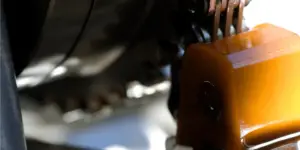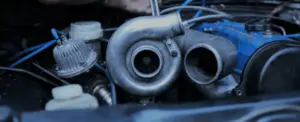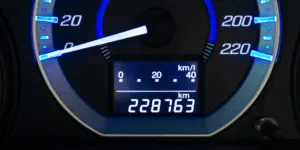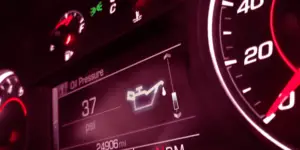Depending on your car’s make and model, a timing belt is due to be replaced between 60000 and 100000 miles.
A timing chain usually needs replacing at 100000 miles.
There are certain signs that your timing belt may be failing outside of the recommended replacement periods. Below we’ll examine each of the six symptoms and what ignoring them could mean for your engine and your pocket.
Before we get to it we’ll briefly explain what a timing belt does:
What Does a Timing Belt Do?
The timing belt is situated inside the engine and synchronizes the timing between the crankshaft and the camshaft. A timing belt is often called a cambelt.
Many people get confused between these terms and a serpentine belt which is something completely different.
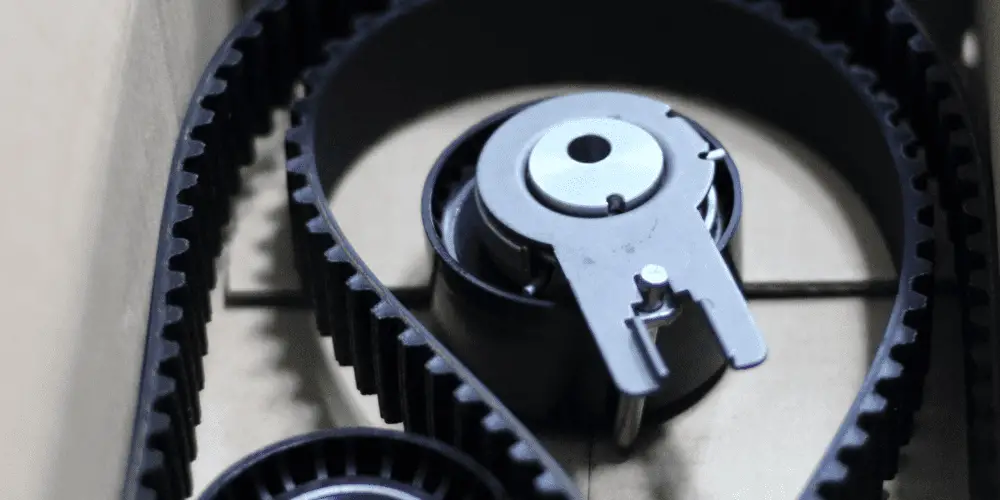
The timing belt is the most important one in your vehicle as it ensures the engine parts operate in unison exactly at the time when they are supposed to.
How Long Does A Timing Belt Last?
A very common question is when does a timing belt need to be replaced. The answer varies between different car manufacturers. Each will stipulate when the belt needs replacing. Some suggest as soon as 60000 miles while others recommend replacement at around 100000 miles. Another stipulation may be the number of years since it was last replaced.
You may find your car manufacturer’s guidance state 60000 miles or five years, whichever comes sooner.
Honda, for example, recommends that the timing belt be changed every 100000 miles, whereas Ford recommends every 60000 miles from most of their models.
Why Is It So Important To Replace The Timing Belt?
Timing belt manufacturers understand the importance their belts play within the engine.
Timing belts are made of either Kevlar or toughened rubber to ensure durability.
Ignoring the manufacturer’s replacement guidelines or ignoring the signs that it needs changing can cause catastrophic damage to your engine. Sometimes the damage is so severe it makes a repair uneconomic.
What Else Should Be Changed As The Same Time As A Timing Belt?
The timing belt is guided by the idler pulleys and kept at the right tension by the belt tensioner. In addition, the water pump is run from the timing belt.
All these parts are cheap to replace, so it’s cost-effective to have them replaced simultaneously. If your belt needs replacing, then the parts that support it are likely close to the end of their life too.
As labor is the largest part of the cost of accessing this engine area, it makes sense to replace all the parts once access has been gained. A new water pump costs $40 to $80.
Are Timing Belts The Same As Timing Chains?
Timing belts and timing chains serve exactly the same purpose. The only difference is the material they are made from.
Timing belts are made of Kevlar and high-density rubber, whereas timing chains are made of Metal and resemble bicycle chains.
Because they are made of metal, timing chains last longer than timing belts. Most car manufacturers that use timing chains recommend they be changed every 100000 miles
How To Know When To Replace A Timing Belt – What Are The Signs?
All manufacturers will stipulate when the timing belt needs to be changed, but there are other warning signs that you should get your belt replaced sooner.
Squealing Noise
Sometimes when the teeth on the cambelt are not engaging properly they can slip and squeal.
It is worth noting that other belts also cause a squealing noise.
A squeal from a revving engine will be from the Serpentine belt, which runs many components in your car.
The serpentine belt is an external belt. If you can turn the belt between your finger and thumb more than half of an inch, it is loose. You can also check for worn teeth too.
Another check would be to get someone to press the gas pedal while you listen close near to the serpentine belt. If this belt isn’t squealing, but you still hear the noise, the timing belt inside the engine is likely slipping.
Misfiring Engine
The timing belt keeps the engine synchronized. Any belt failure can cause it to misfire and run rough. The belt runs all the pistons inside your cylinders and a slight misfire may result from one cylinder being slightly out of alignment.
More severe misfiring could mean that more pistons are not operating correctly within their cylinders, and the belt is closer to failing completely.
Oil Leaks and Low Oil Pressure
It always pays to look for an oil leak around the belt cover at the side of the engine. A leak will result in low oil pressure. Another way that a timing belt can cause low oil pressure is if the belt starts to lose its teeth which then congregate in the oil pan. This stops the oil from reaching the top of the engine and reduces the oil pressure.
Ticking Noise
Bad oil pressure will mean that the oil is not getting to the top of the engine and lubricating the valves. This will be more noticeable under acceleration.
Blue Smoke From The Exhaust
An engine with bad timing will not burn fuel efficiently, causing any unburnt fuel to leak out of the exhaust with the fumes. Unburned gas or diesel will have a blue tinge to it it.
Poor Fuel Economy
It is quite normal for the fuel economy to drop by more than 10 miles per gallon when the timing belt is close to failing. The engine is unable to run efficiently and needs to burn more fuel to compensate.
If your car is exhibiting any of these faults, it will pay to have your vehicle checked over by a mechanic. Prevention is truly better than cure when it comes to the timing belt.
What Does It Cost To Replace A Timing Belt?
The timing belt itself is cheap. Expect to pay no more than $50 to $75 for a new one. Labor can add up to around $300.
Some competent DIY mechanics will change the timing belt themselves. However, for most people, the risk of doing something wrong and the timing belt failing causing catastrophic damage to the engine is not worth the risk. For peace of mind, most people go to to a car shop instead.
Expect to pay between $100 and $150 for a timing chain and an additional $200 for labor.
In Conclusion
- Always get your timing belt replaced in line with the car manufacturer’s guidelines. It is generally recommended between 60,000 and 100000 miles
- If you experience poor performance, squealing or ticking, blue exhaust smoke, or low oil pressure, get your car to a car shop – even outside of the recommended change intervals.
- A timing belt costs approximately $300 to replace, including labor
- It is better to get the pulley tensioner and water pump replaced at the same time too.
All you need to know about the signs of a stretched timing chain
Some people report their car feels different after a timing belt change and worry. Find out how and why in our recent article : Here’s Why A Car Can Feel Different After A Timing Belt Change


